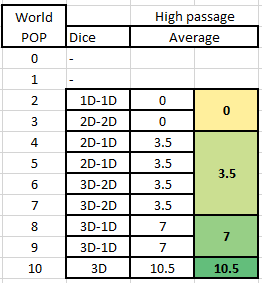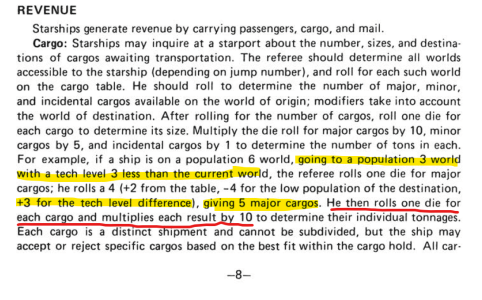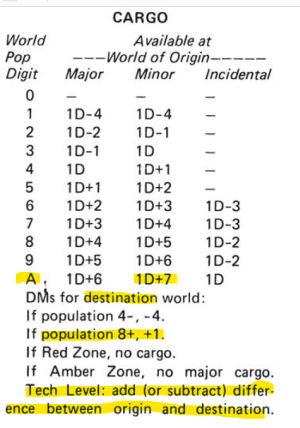Observations:
Looking at the high passage results you should plan for at least 3 High passengers,
The average result is ~3.48, if you skip POP 0 & 1 worlds, it rises to ~3.96.
This is where things start getting fun when you start computing the economic throughput ... and their implications for starship designs intended for "load balancing" of supply vs demand in an idealized way.
If you go as broad spectrum as possible, you're going to want 3-4 high passengers and no more so as to meet your accommodations capacity of 3-4 staterooms. However, 3-4 high passengers gets hard to justify in terms of crew salaries+life support overhead expenses. This is going to require a bit of modeling, so bear with me for a moment.
Keep in mind that subsidized operations have a 50% ticket revenue "rake" by the subsidizing government, while all overhead expenses are borne in full by the operator. This causes various asymmetries to occur at a variety of breakpoints between subsidized and non-subsidized operations (so straight multiples of 1:2 don't work properly when guesstimating profit differentials, because the details matter).
- Steward + 3 high passengers = 4 staterooms (16 tons), Cr30,000 ticket revenue, Cr1500 per 2 weeks crew salary, Cr8000 life support overhead
- Net revenue: Cr5,500 per 2 weeks (subsidized), Cr20,500 per 2 weeks (non-subsidized) for 16 tons
- Profit per ton: Cr343.75 per 2 weeks (subsidized), Cr1281.25 per 2 weeks (non-subsidized)
- 4 middle passengers = 4 staterooms (16 tons), Cr32,000 ticket revenue, Cr8000 life support overhead
- Net revenue: Cr8000 per 2 weeks (subsidized), Cr24,000 per 2 weeks (non-subsidized) for 16 tons
- Profit per ton: Cr500 per 2 weeks (subsidized), Cr1500 per 2 weeks (non-subsidized)
- 16 tons of cargo = Cr16,000 ticket revenue
- Net revenue: Cr8000 per 2 weeks (subsidized), Cr16,000 per 2 weeks (non-subsidized) for 16 tons
- Profit per ton: Cr500 per 2 weeks (subsidized), Cr1000 per 2 weeks (non-subsidized)
What this means is that at low numbers of high passengers to stewards (3-4:1) you are reducing profit margins.
So for comparison purposes, what happens if you double the number of high passengers, making the "uptime" of the Steward "more efficient" in operational terms?
- Steward + 8 high passengers = 9 staterooms (36 tons), Cr80,000 ticket revenue, Cr1500 per 2 weeks crew salary, Cr18,000 life support overhead
- Net revenue: Cr20,500 per 2 weeks (subsidized), Cr60,500 per 2 weeks (non-subsidized) for 36 tons
- Profit per ton: Cr569.44 per 2 weeks (subsidized), Cr1680.56 per 2 weeks (non-subsidized)
- 9 middle passengers = 9 staterooms (36 tons), Cr72,000 ticket revenue, Cr18,000 life support overhead
- Net revenue: Cr18,000 per 2 weeks (subsidized), Cr54,000 per 2 weeks (non-subsidized) for 36 tons
- Profit per ton: Cr500 per 2 weeks (subsidized), Cr1500 per 2 weeks (non-subsidized)
- 36 tons of cargo = Cr36,000 ticket revenue
- Net revenue: Cr18,000 per 2 weeks (subsidized), Cr36,000 per 2 weeks (non-subsidized) for 36 tons
- Profit per ton: Cr500 per 2 weeks (subsidized), Cr1000 per 2 weeks (non-subsidized)
So on a "purely Evil Bean Counter™" basis, high passengers are not economically competitive (in profit per ton "density" terms) until you've got accommodations for ~6 high passengers. The profit per ton "revenue density" threshold to beat is Cr500 per ton (subsidized) compared against middle passengers/cargo ... and Cr1000 per ton (non-subsidized) compared against cargo or Cr1500 per ton (non-subsidized) compared against middle passengers.
- Steward + 5 high passengers = 6 staterooms (24 tons), Cr50,000 ticket revenue, Cr1500 per 2 weeks crew salary, Cr12,000 life support overhead
- Net revenue: Cr11,500 per 2 weeks (subsidized), Cr36,500 per 2 weeks (non-subsidized) for 24 tons
- Profit per ton: Cr479.17 per 2 weeks (subsidized), Cr1520.83 per 2 weeks (non-subsidized)
- Steward + 6 high passengers = 7 staterooms (28 tons), Cr60,000 ticket revenue, Cr1500 per 2 weeks crew salary, Cr14,000 life support overhead
- Net revenue: Cr14,500 per 2 weeks (subsidized), Cr44,500 per 2 weeks (non-subsidized) for 28 tons
- Profit per ton: Cr517 per 2 weeks (subsidized), Cr1589.29 per 2 weeks (non-subsidized)
Incidentally, the stock J1 Free Trader and J2 Far Trader are designed and crewed for ... 6 high passengers ... although the J2 Far Trader is capable of hosting a 7th high passenger if there is sufficient ticket demand.
The net upshot of this factor is that starships designed (and crewed) to accommodate high passengers will tend to set a minimum floor of 6-8 high passengers "expected" to be onboard at all times, in order to justify the capability to transport them in profit/loss terms of jump to jump operations. This factor then skews the preferences for routing among tramps and free traders, since they need to "go" where the demand is high enough to justify the voyage(s) ... which then pushes them towards worlds with higher populations (increasing ticket demand) or towards declaring multiple destinations in advance and committing to a course plot in order to "work through" a region of low population (to get to the other side).
The real challenge is working out how to build a starship in detail that can "thrive" in even regions of low population (4-) by making a profit where competitors are "naturally deterred" by the poor prospects of return on the voyage expenses. In business economics, just like in nature, if you can survive where others fail and fall, you can both "corner the market" and let the "harshness" of the economic environment deter/prevent competitors from encroaching on your (business) territory. Needless to say, this has all kinds of knock on (social) consequences for such low end penny ante operators, grinding out profits at the the extreme low end that no one else will touch (because they can't make a profit there without "changing
horses starships" to try and compete.
My current sense is that low population worlds (4-) are best served by sub-200 ton starships operated by minimalist crews (1 or 2 at the most!). It then turns into a "price is right" type of deal, where you want the "biggest sub-200 ton hull" as can be practically designed in order to maximize revenues while minimizing expenses (annual overhaul costs, mortgage financing, etc.) in an attempt to keep the business model in the black.
Needless to say, for security reasons, this quickly turns into an "interstellar delivery van" type of business model, where passengers are a security risk for minimalist crews (because hijacking is a thing) and the REAL money to be made is in speculative goods arbitrage instead of in ticket revenues. So the smarter play is to dump the passenger capacity entirely, have a crew of 1-2 (pilot/gunner or pilot+gunner) and fly around with the largest cargo hold you can fit into 199 tons or less while still having enough drive performance to get appreciable interstellar range and have enough maneuver acceleration/agility to outrun pirates (or customs enforcers, depending on what's in your cargo hold). You use mail delivery as guaranteed revenue to pay the bills (and turn a small but consistent profit) while wheeling and dealing in speculative goods and playing catch as catch can on any freight tickets "going your way" as necessary to keep your cargo hold filled along the way. Very much a "low end" penny ante type of "courier" operation, but one that can be incredibly lucrative when operating in regions where there is a good mix of trade codes (preferably all of them) so as to maximize returns on speculative goods arbitrage.



